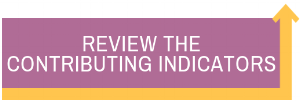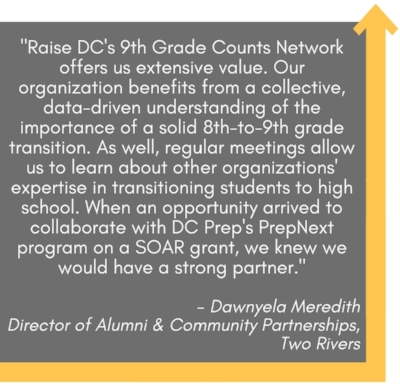High School Graduation
Raise DC's high-level goal: Every youth graduates from high school.
We aim to increase the percentage of youth who graduate from high school on time and are college/career ready.
Click on the buttons below or scroll down to see citywide data from the Office of the State Superintendent of Education on the indicators Raise DC tracks related to high school graduation, as well as Raise DC's programmatic work toward this goal.
We recommend viewing the following data on a desktop or laptop to fully explore an interactive version of the indicators disaggregated by a number of demographics.
Core Indicator: Adjusted cohort graduation rate
The Office of the State Superintendent of Education (OSSE) tracks DC's high school graduation rate using the federal "cohort" model (the Adjusted Cohort Graduation Rate, or ACGR), which calculates the number of students in DC Public Schools (DCPS) and public charter schools who graduate within four years of first entering high school. This measure serves as Raise DC's core indicator; view that data in the first tab below. Additionally, many of Raise DC’s partners recognize the importance of also tracking the five-year graduation rate, which is also reported below for years in which it is available.
Source: Office of the State Superintendent of Education, 2017-18 Adjusted Cohort Graduation Rate; see Data Dictionary for more. Note: Data on five-year graduation rates is unavailable for 2016 and 2018.
High school graduation rates have seen overall gains since Raise DC began tracking this core indicator, even with its most recent dip in 2018. However, with a citywide four-year rate at 68.5%, this means that more than 30% of our public high school students still do not graduate in the expected timeframe. We know that a high school degree or diploma is a critical stepping stone to earning sustainable wages in a future career, and Washington, DC, falls below the nationwide rate of 84%.
Note: Raise DC uses citywide graduation rates from OSSE as its official number. After graduation rates were called into question in late 2017, OSSE conducted a thorough review of public school reporting and policies. For more on this, please visit OSSE’s website.
DISAGGREGATED DATA
Raise DC has made a commitment to disaggregating data by key demographic factors in order to shine a light on where we can best make progress toward our high-level goal of improving high school graduation rates. Disaggregating data means breaking down information into smaller sub-populations, such as race/ethnicity, sex, and other demographic factors. Identifying where differences exist is an important step to understanding and addressing inequities in our community.
DISAGGREGATION BY RACE/ETHNICITY
While graduation rates have risen for all racial/ethnic groups since Raise DC’s last Progress Report, disparities are still prominent. Data on the second tab in the above visualization shows that White/Caucasian students have historically graduated in four years at a higher rate (ranging from 85% to 91%) compared to their Black/African American (ranging from 60% to 73%) and Hispanic/Latinx (ranging from 62% to 72%) peers. It’s also important to note the racial/ethnic composition of students in DC’s public and public charter schools when considering these disparities and potential actions to take. In the Class of 2018, for example, approximately 73% of students identified as Black/African American, 17% as Hispanic/Latinx, and just 5% as White/Caucasian.
DISAGGREGATION BY OTHER DEMOGRAPHIC FACTORS
The third tab in the visualization gives us a look at graduation rates for students who are considered economically disadvantaged, students with disabilities, and English Language Learners. This data shows that students in these categories have disproportionately lower graduation rates.
For example, 49% of students with disabilities graduated in four years, compared to nearly 69% of the citywide figure. That graduation gap has remained around 20% for the past five years.
While four- and five-year graduation rates have seen overall improvements among nearly every subgroup since 2013, rates for English Language Learners have remained static in this time period.
CONTRIBUTING INDICATORS
Raise DC tracks several contributing indicators that influence the core indicator and, in turn, our citywide, high-level goal of high school graduation. Reflecting commonly accepted measures nationwide, you'll find DC-specific information below about 3rd grade reading and 8th grade math, as well as success in 9th grade.
3rd Grade Reading: PARCC Scores
Raise DC uses OSSE’s Partnership for Assessment of Readiness for College and Careers (PARCC) scores to see how DC's students are faring earlier in the cradle-to-career continuum. Third grade reading PARCC scores have improved since students began this assessment in the 2014-2015 school year, with approximately 31% of students meeting or exceeding expectations now, a 6% increase from the first assessment.
DISAGGREGATED DATA
While scores have improved overall, prominent disparities across racial/ethnic lines still exist (second tab of visualization). For example, while 71% of White/Caucasian students met or exceeded expectations in the most recent assessment, only 23% of Black/African American students and 27% of Hispanic/Latinx students achieved the same results.
8th Grade Math: PARCC Scores
Similar to data in 3rd grade reading, 8th grade math PARCC scores have improved over the past four years, yet only approximately 26% of students met or exceeded expectations overall last school year.
DISAGGREGATED DATA
Data disaggregated by race/ethnicity reveals wide disparities among students within each 8th grade cohort (second tab of visualization). For example, only about 17% of Black/African American students and about 23% of Hispanic/Latinx student met or exceeded expectations in school year 2017-2018, compared to nearly 80% of their White/Caucasian counterparts.
In addition to this data, Raise DC recognizes that disparities early on in the high school pipeline may predict barriers to improved graduation rates. While examining cohorts of students who started in 9th grade between 2006 and 2009, Raise DC’s Graduation Pathways report found that approximately 25% of a student’s chances of graduating from high school could be accounted for by 8th grade characteristics, including attendance, course performance, special education, and English Language Learner status. Additional research suggests that students arriving at 9th grade who read below grade level or have not mastered basic math skills are more likely to be retained, fail courses during their freshman year, and remain off track for graduation.
9th Grade SUCCESS
National research indicates that success in 9th grade is highly predictive of on-time high school graduation. One measure – promotion to 10th grade – is seen as a critical step toward graduation and is used to gauge the effectiveness of strategies to support 9th grade students. Other measures of 9th grade success vary among school districts across the country, but many often include a combination of attendance, behavior, and course performance indicators.
Through Raise DC's 2014 Graduation Pathways report, citywide 9th grade data highlighted that 46% of first-time 9th graders (in 2008) ended their freshman year “off track,” meaning they were low on accumulating credits and had a high number of unexcused absences. The vast majority of students who fell off track eventually dropped out of school.
As the citywide graduation rates continue to shift into focus, and as students continue to enroll across DCPS and charter LEAs, developing a shared measure to consistently gauge the status of DC's 9th graders is an important step to continuously improving their chances of graduating from high school prepared and on time.
acting on the data
Armed with these measures of how our young people are faring in high school and prior, as well as an understanding of some of the demographic factors that further illuminate it, Raise DC's high school graduation-focused work provides opportunities to act on the data. Learn more about these efforts below. Have ideas on other ways to use this data for action? Reach out to Raise DC in the Get Involved section below.
OUR WORK
In response to troubling data about the success of our youth in secondary education, Raise DC is currently focusing efforts on 9th grade – including the transition to high school, success throughout this year, and promotion to 10th grade. This work primarily exists under the umbrella of the Graduation Pathways Project, a multi-sector initiative that ensures every youth – no matter how far off track they may be – has a path to graduation. The Graduation Pathways Project has become a springboard for numerous strands of work (Click links to learn more):
9th Grade Counts Network – our Change Network that focuses on the successful transition to and through 9th grade
Graduation Pathways Summit – the annual convening of schools, agency leaders, and nonprofit partners that elevates strategies to ensure all youth have a path to graduation
Bridge to High School Data Exchange – a standardized process (now managed by OSSE) for ensuring essential early warning information is transferred quickly, automatically, and consistently as students enroll in 9th grade
Bridge to High School Kid Talk – an extension of the Data Exchange offering middle schools and high schools an opportunity to connect in person to share crucial qualitative date that allows them to plan supports for students to and through their freshman year
Engagement of student voice – findings and insights from focus groups conducted with high school students who had fallen off track
Learn more about Raise DC’s Change Networks and the student populations they serve.
Spotlight: 9th Grade Counts Collaboration
After meeting as members of Raise DC’s 9th Grade Counts Network, staff from Two Rivers Public Charter School and DC Prep (and its PrepNext program) formed a partnership to see how DC Prep’s Alumni Support Model, which provides dedicated support for students moving from middle to high school and throughout their first year, could be replicated with another institution. The two local education agencies (LEAs) teamed up to win a two-year OSSE Scholarship for Opportunity and Results (SOAR) Act grant to fund numerous activities that supported this critical transition point.
These initiatives included:
Hiring an additional PrepNext Alumni Support Counselor: This additional counselor made it possible for the PrepNext team to support the additional caseload of Two Rivers students.
Creating cross-LEA training opportunities: Two Rivers staff joined DC Prep planning meetings to gather insights on modeling a full team to support rising 9th graders.
Developing cross-LEA alumni activities: DC Prep and Two Rivers created joint programming for staff and students to interact and learn from one another.
Building an Alumni Data Dashboard: Modeled after DC Prep’s system, the Two Rivers dashboard created a way to organize existing data and determine what additional data to collect on students to ensure their success.
Establishing cross-LEA transition workshops for students: DC Prep and Two Rivers shared 8th grade materials to help students on the path to high school.
Dawnyela Meredith, Director of Alumni and Community Partnerships at Two Rivers, said the LEAs have formed a strong collaborative partnership, bouncing new ideas off one another and sharing insights.
“The PrepNext team has always been very gracious in answering my questions throughout this collaboration, knowing it is in service of DC students,” Meredith said. “We had the opportunity to invest in a deep partnership that will continue in the future.”
Jill Salisbury, Director of PrepNext, said she hoped the work achieved through this collaboration would eventually allow 9th graders to have fewer course failures, greater promotion rates to 10th grade, and, ultimately, stronger high school graduation rates.
“Both of our programs have benefited immensely from this partnership,” Salisbury said. “We have seen a lot of potential for impact from a sustained relationship like the one we have with Two Rivers.”









